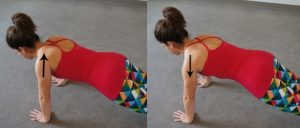Written by: Nathaniel Christoforou (Exercise Science student, Deakin Unviersity)
Everyone with an interest in strength training knows the importance of targeting the large muscle groups such as those in the legs, back and chest: as these help build muscular strength. Training these larger muscles is also visually appealing. However, in many training circles it’s often the smaller, deeper muscles that are overlooked. There is a gap in the understanding of these smaller muscles and the vital role they play in postural and functional support.
So, what is arguably the most neglected muscle in resistance training? We are frequently told to retract or pull back our shoulder blades, however, we often forget to emphasize the importance of the opposite – protraction! Protraction is the pulling of the scapula forward and around the rib cage, for example, when throwing a punch. The muscle that allows us to complete this movement is one of the most neglected muscles in training, the Serratus Anterior. This muscle originates on the surface of the 1st-8th rib at the side of the chest and inserts along the entire anterior length of the medial border of the scapula.
Implications of a weak Serratus Anterior:
There are many functional and postural issues that arise from having an underworked serratus anterior. As aforementioned, it will lead to complications in efficiently protracting the shoulder blades. Therefore, any movement where you push against something, such as during a push-up, will be negatively affected. There is an increased likelihood of injury, while it also contributes to neck and back pain. If the serratus anterior is weak, other muscles are required to compensate for movement, such as the trapezius. This puts extra stress on these muscles as they are not ideally used in these movements, resulting in pain.
In today’s day and age, where life revolves heavily around technology, a forward shoulder lean is very common as our body adapts to the positioning of computer work. A key component to this is the lengthy periods that the serratus anterior spends in a shortened position. As the serratus anterior is chronically shortened, its ability to lengthen is compromised. Thus, the shoulder loses its ability to retract, resulting in this ‘hunching’ of the shoulders.

Exercises to strengthen your Serratus Anterior:
We’ve spoken in depth about the implications of a weak serratus anterior, but how can we work on repairing this? Here are 3 exercises that you can begin incorporating into your training program to strengthen your serratus anterior.
- Scapula wall protractions:
Lean against a wall, placing your hands flat against it, with a very slight bend in your arms. Position your feet a suitable distance back so that there is a slight forward lean in your torso. This position will become clearer to you as you begin the exercise. Start by retracting, or pulling back your shoulder blades, which will bring your chest forward. Do not bend at the arms throughout this. Then, protract your shoulder blades, fully extending your back. You should feel this in the serratus anterior. Throughout this exercise, focus on the correct movement, and therefore retraction and protraction, of the scapula. Completing at least 10 repetitions for 3 sets is sufficient.
2. Scapula push-ups:
This exercise follows a similar concept to the scapula wall protractions; however it is more challenging. Start in a push-up position, with hands placed directly under your shoulders. From here, as above, we are simply going to retract and protract our shoulder blades, allowing our chest to move up and down a few inches. Completing 3 sets of 10+ repetitions is again a good protocol to follow.

3. Dumbbell Pullovers:
This is the most complex of the 3 exercises, so progress to this as you feel comfortable. Please ensure you are always safe completing each exercise, and ask any trainer for some assistance if required. For this exercise we are going to use a dumbbell. Start with a light weight, as you will be lifting it above your head and body. Lie on a flat bench, with your head all the way up to the end of it. From here, lift the dumbbell above your body, and fully extend over your head until you feel a stretch through your chest/serratus anterior region. Return back to the starting position, and repeat this for about 10-12 repetitions. To exit, bring the dumbbell slowly down to your body and sit up, or have a trainer take it from you when you complete your final rep.

I hope this article improved your knowledge on the importance of the serratus anterior and the functional and postural roles it plays, as well as how you can begin strengthening this muscle. If there is ever any confusion with any of these exercises, please ask one of the staff at Inspire Fitness and we’ll be more than happy to demonstrate in order to make things easier!
At Inspire Fitness we use corrective exercise with your personal training and exercise physiology in combination with general fitness training to ensure you maximize the results from your exercise. Our assessment process will scientifically analyse any weakness or dysfunction in your stability mechanisms (such as weakness in Seratus Anterior)
Reference List:
Martin, R.M. and Fish, D.E., 2008. Scapular winging: anatomical review, diagnosis, and treatments. Current reviews in musculoskeletal medicine, 1(1), pp.1-11.
The bar method 2015, scapular pushups, the bar method, retrieved 27 June 2018, <https://barmethod.com/the-most-neglected-muscle-during-exercise-the-serratus-anterior/>
